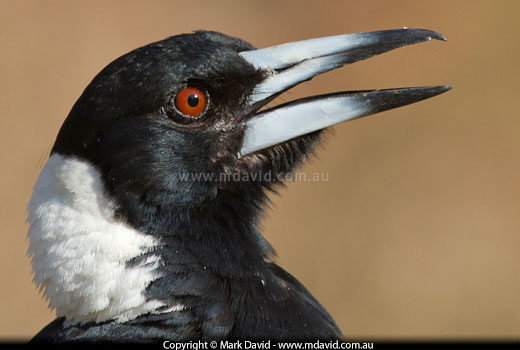The Australian Magpie (Gymnorhina tibicen) is a bird familiar to most Aussies.
It has a mixed reputation. Some call it a nuisance for sometimes swooping at people
at breeding time. Others welcome it into their gardens as a handsome and normally gentle
bird. I fall firmly into the latter group.
What do they look like?
Magpies are one of those birds which, in my opinion always appear to be bigger than you expect. Yeah, I
know, that’s not much help to you. But a healthy mature magpie can reach an imposing 44 cm
length from the tip of its bill to the end of its tail. Perhaps it’s the calm, assertive poise
of a dominant male magpie which makes it appear bigger.
A healthy mature specimen will have glossy
black and white feathers. Its beak will be pale but with a dark point. Immature magpies have a
ruffled look about them, with plumage more mottled grey/brown and black and white than just black
and white. The photos on this page should give a good idea although keep in mind that there is another
‘race’ of Australian Magpie which has much more white running down its back.
Where are they?
Throughout most of Australia. They form part of the landscape of countless parks and
suburban back yards.
Social life
Australian Magpies usually hang around in a group. It might just be a pair or a small
family, but numbers in some groups can reach 20 or more. Groups of birds will defend their
territory from other groups, and will often burst into song (called carolling) after successfully
defending their turf.
Nesting
With some birds, like Brush Turkeys, nest building is
done by the male. But with the Australian Magpie, the nests are built by females. Nests are
built in trees and made of twigs and other plant matter, then lined with bark or other softer
materials. Up to 5 eggs are laid.
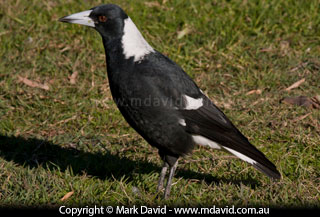
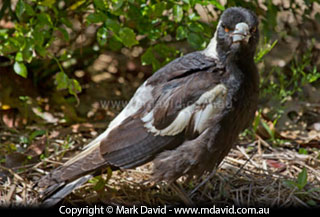
Mature Australian Magpies are black and white. Young ones like
the bird shown in the second photo reveal their age by having a ruffled, mottled
grey/brown and white appearance
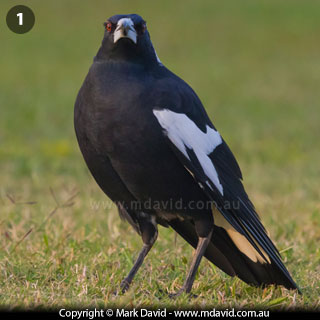
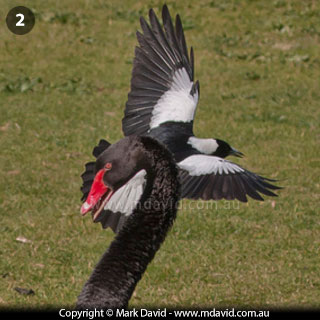
1: The imposing stance of a healthy mature Australian Magpie as it studies me,
probably making up its mind about whether I’m dangerous. 2:
Despite the fact that the Black Swan was no threat to the magpie or its
young, this magpie repeatedly swooped and harassed the swan until the larger bird left the
area.
Swooping
When magpies are breeding you might hear stories about (or experience personally) an example
of a magpie swooping at people. I’ve seen this happen myself although that kind of
behaviour is not normal for them. There are a bunch of theories around to explain their swooping. Some
people suggest the birds are just showing off at a time when the male birds want to look their
best and toughest in the eyes of the females. Some suggest the birds are swooping at people who
fail to respond to early warning signals from the birds to stay away from their young. Others
suggest the birds might have developed a bit of bad attitude to humans as a result of humans
treating them badly when they were young.

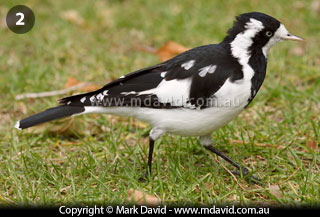
1: Female magpies have a dappling of grey-tinged feathers on the
base of the back of their neck. The male bird is in the foreground. 2: The Australian
Magpie Lark is sometimes mistaken for an Australian Magpie. The Magpie Lark, however, is
much smaller and lacks the black tip on its bill.
To complicate matters, swooping isn’t always directed at creatures that pose a threat
to their young. I once watched a Magpie constantly swooping a Black Swan, which kind of annoyed
the swan. Since Black Swans are herbivorous they would not pose a threat to the Magpies.
The thing is, when Magpies are breeding, the males experience a huge surge in hormones.
Perhaps think of a swooping Magpie as going through something like a bit of ‘roid rage’.
So you have your highly-strung bird, full of hormones and not coping too well with the responsibility
of looking after its young. And then someone pedals right through the middle of its territory on
a bicycle.
So, whatever the reason, allow yourself to be reassured that the swooping behaviour will most
likely ease off once the young have matured a bit. It shouldn’t last longer than perhaps a
few weeks.
I’ve read about some magpies that will keep on attacking forever but those birds are
mighty rare.
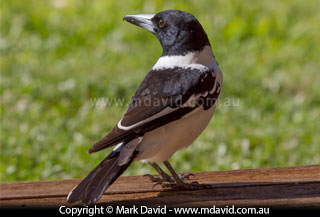
The Pied Butcherbird is another bird easily confused with the Australian
Magpie. Compared with the Magpie, the Pied Butcherbird is a slightly smaller bird with a much
more noticeably hooked beak.
Territories
Magpies spend a lot of time defending their territories. The place where I live, for example,
sits right on the border between the territories of two groups of Magpies, with one group
claiming rights over one side of the lawn and the other group claiming the other side.
I have never seen the birds cross sides. In this type of situation, a large group
of birds will have a big advantage in defending their turf over a small one, and so some people
think this is a reason why they hang around in groups. I’ve enjoyed watching the birds from
a distance and allowing them to watch me, to let them get used to the idea that I’m
also part of their territory but not a threat to any of them.
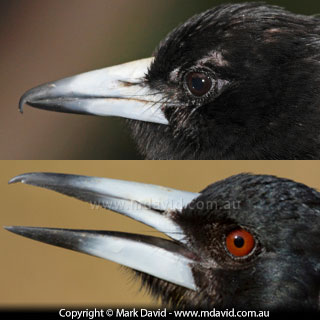
These two photos compare the sharply hooked beak of the Pied Butcherbird
(top) with the Australian Magpie (below).
The birds seem to accept me up to a point but have no tolerance for the other groups invading
their territory. Standoffs at the border sometimes occur with lots of carolling and occasionally
swooping and chasing. But all that stuff never lasts for long and the birds on both sides invariably
end up peacefully walking the lawn looking for food again.
What do they eat?
Magpies like to feed by walking along the ground in their group, picking up things like
worms, insects, spiders and small frogs.
If some of them swoop, then what’s so great about Magpies?
A bit of swooping by a minority of Magpies over a small amount of time is a tiny price to
pay for having these fantastic birds around. They are handsome, intelligent and inquisitive birds
and most of them are gentle and calm creatures. And chances are, most of the things they feed on are the
things you probably don’t want to have around anyway. Watching a family of these birds
quietly roaming their territory is a delightful way to calm down after a day spent fighting for
parking spaces and trying to be polite to telemarketers. They (the Magpies, not the telemarketers)
are some of my favourite creatures.
And apart from all that, these birds are part of our environment and we need our environment to survive.
As long as the magpies are around, I figure I’m seeing things the way they’re meant to be.
References
Field Guide to the Birds of Australia
7th Edition. Ken Simpson and Nicolas Day
Published by Viking (Penguin Group) 2004
Australian Magpie: biology and behaviour of an unusual songbird
Gisela Kaplan
CSIRO Publishing 2004
Reader’s Digest Complete Book of Australian Birds
Reader’s Digest Services Pty Ltd 1976


Birds

